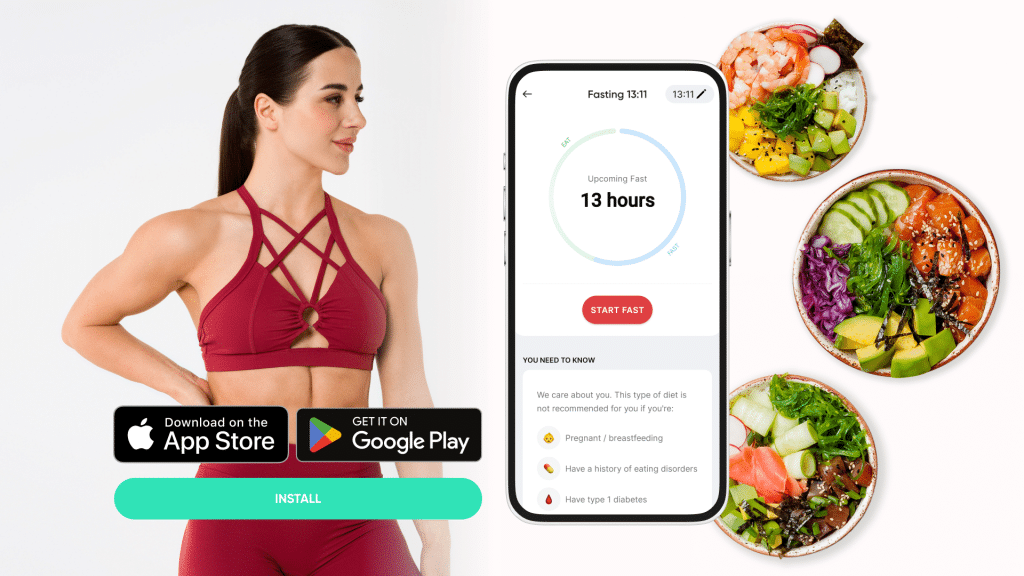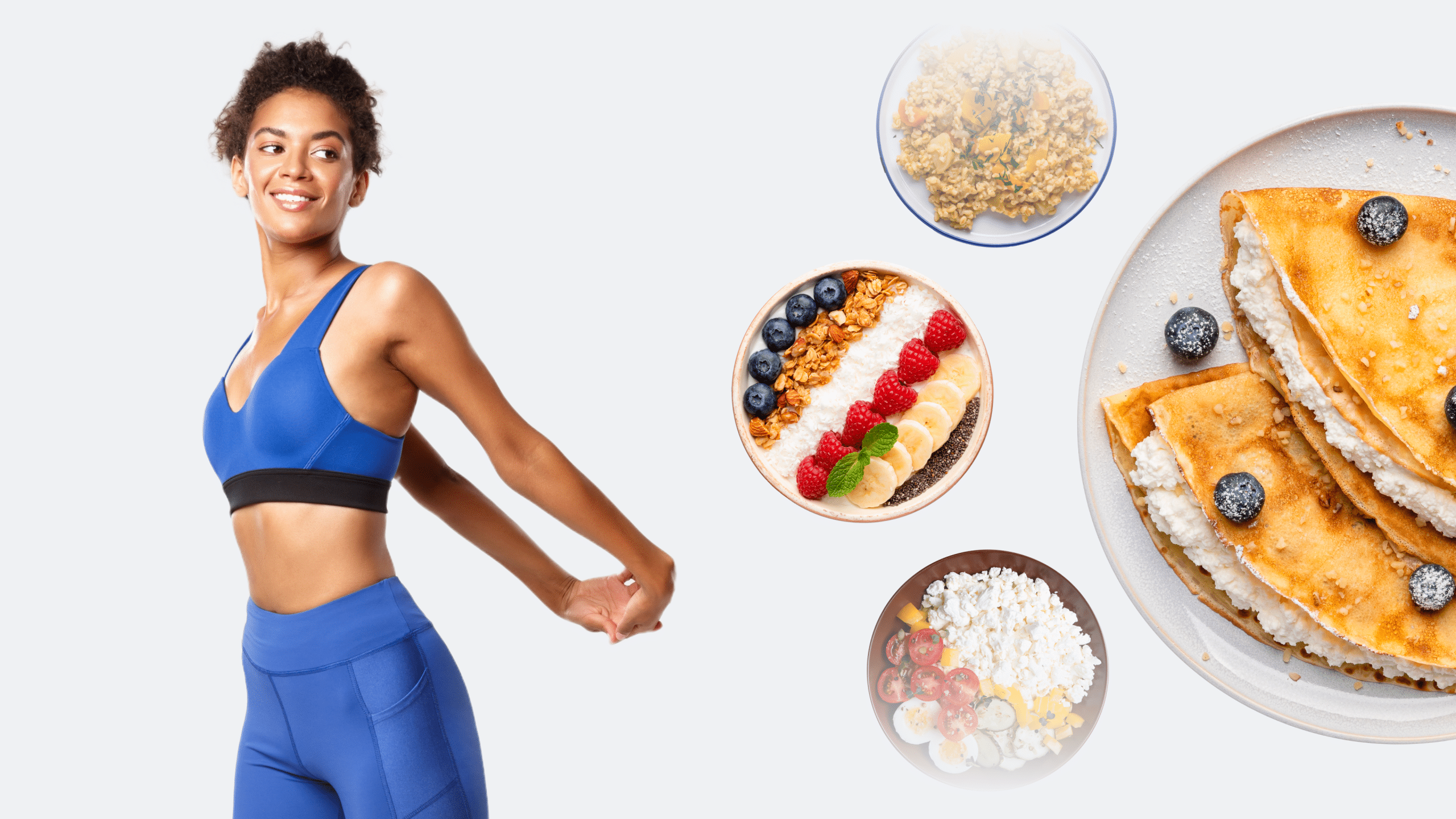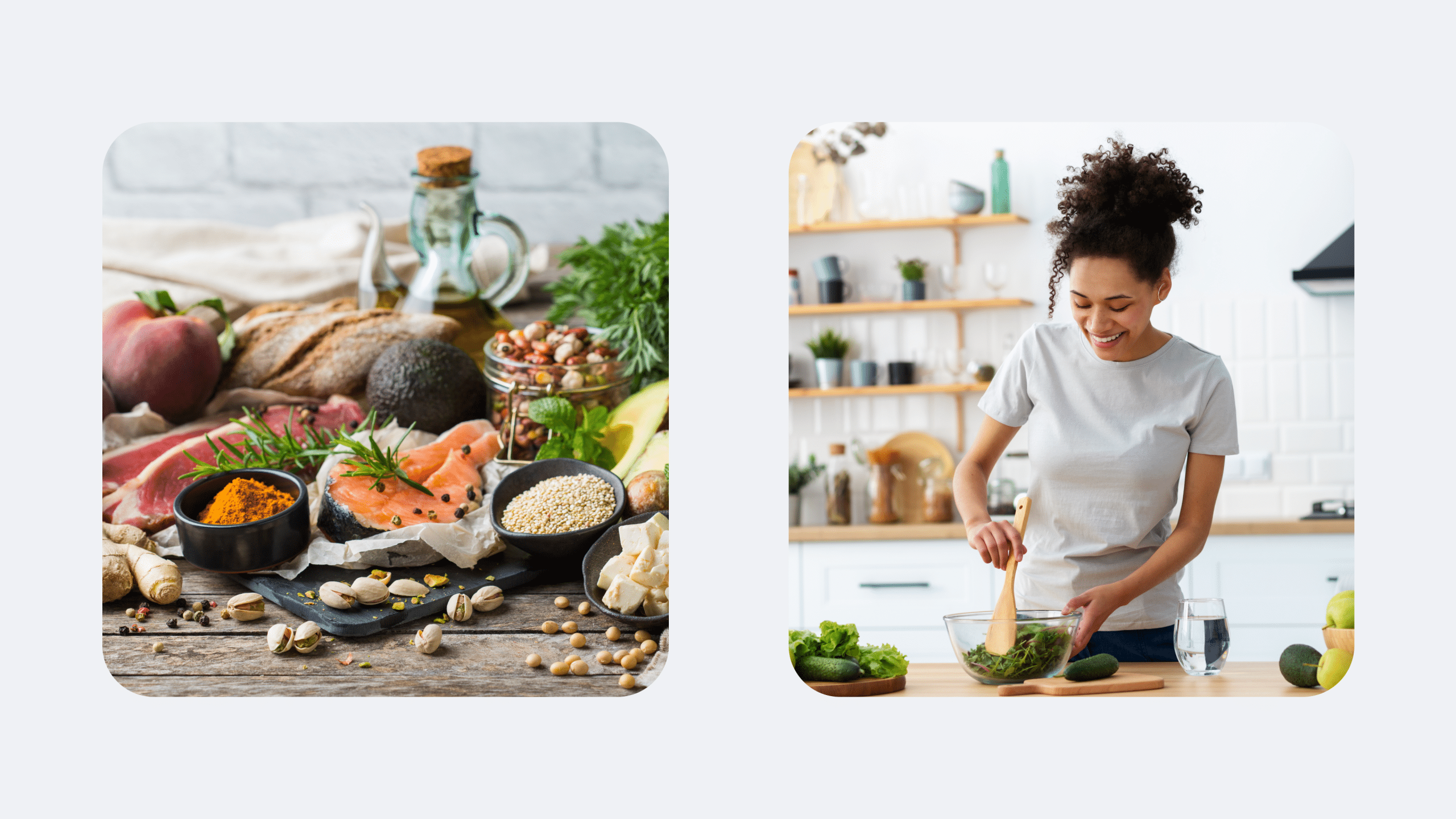The 28-day clean eating challenge isn’t actually a diet. Yes, you heard right! It’s a lifestyle that challenges you to eat clean, which doesn’t mean cutting out everything you love. It has nothing to do with starving or strictly restricting (punishing) yourself.
Instead, the 28-day clean eating challenge is the ideal choice for anyone looking to shed a few pounds, restore their body’s natural state, and enjoy eating a variety of delicious, wholesome foods. Let’s show you how to enjoy the challenge.
What Is the 28-Day Eating Clean Challenge?
The 28-day clean eating challenge is a lifestyle choice that welcomes whole, nutritious, and natural foods, sometimes including foods from group one: unprocessed or minimally processed. It definitely excludes all unnatural or altered foods in groups two to four (26):
- Group 1: Food minimally processed and comes close to their natural state
- Group 2: Food changes from its natural state for ingredients like salt and sugar
- Group 3: Food near to natural but has added salt, sugar, or oil, like white bread
- Group 4: Food from additives and ingredients unrelated to group one, like soda
You’ll eat more of group one food, especially those that have no processing unless you need minimally processed food as an ingredient. Here’s a sneak peek at clean food types (16):
- Fruits
- Vegetables
- Whole grains
- Nuts
- Seeds
- Natural oils
- Protein
- Herbs
- Spices
- Beans
- Legumes
If you wish to cinch your waist, tone up your bat wings, blast away the muffin top – our fitness app was created to cater to all your needs! BetterMe won’t give excess weight a chance!
Clean Eating Challenge Benefits
The Mayo Clinic states that clean eating provides your body with the essential nutrients and vitamins that excess food processing may remove (11). Foods in their natural state have more flavor, too. Some benefits you may enjoy from eating clean for 28 days include:
- A stronger immune system
- Good brain health
- Higher energy levels
- Improved cardiovascular health
How Much Weight Can You Lose Eating Clean?
A clean eating plan for weight loss will have you shedding pounds if you do it right. Tosca Reno, the creator of the Eat Clean Diet, told WebMD that you can expect to lose around three pounds weekly by following the rules and sticking to the right foods (13). However, this may not be realistic or sustainable for some. In addition to eating clean food, you must:
- Control your portion size
- Eat 5-6 small portions daily
- Drink tons of water
- Exercise regularly
The Eat Clean Plan recommends eating 1200-1800 calories daily and following the rules to shed pounds (13). However, the Mayo Clinic sheds light on how much cardio and strength training is recommended to support weight loss (15):
- 150 minutes of moderate or 75 minutes of high-intensity cardio weekly
- One set of 12-15 reps to strength train major muscle groups twice weekly
How Much Weight Can You Lose on the 28-Day Clean Eating Diet?
A clean eating challenge for weight loss requires keeping your calories to a minimum. You’ll have to be conscious of your calorie intake to know how many pounds you could lose over 28 days. The Mayo Clinic states that 3,500 calories equals one pound of fat (12).
That number helps to determine the minimum weight you can lose in 28 days. You could lose a pound each week without effort if you reduce your daily calorie intake by 500. This means you’ll effortlesly lose four pounds over 28 days. Add exercise, and you burn more calories.
Harvard shows how many calories you burn in 30 minutes doing the following if you weigh 155 pounds (9):
- Vigorous calisthenics: 306
- High-intensity cardio: 252
- Brisk walking: 175
- Swimming: 216
- Running: 288
Add workouts as recommended to your 28-day clean eating challenge, and lose another pound weekly for every 3500 calories burned.
What Are the Rules for the Clean Eating Challenge?
The 28-day clean eating challenge works when you know the rules. WebMD lists the rules you should follow to eat clean and enjoy the benefits (1):
- Eat whole, natural, organic, raw, or group one food
- Eat whole-grain pasta, bread, and rice
- Consider organic produce free from artificial pesticides
- Eat lean organic or humane dairy and protein products
- Eat seafood with a low mercury count
- Have 5-9 servings of fresh or plain frozen fruit and vegetables daily
- Avoid added salt or sugar in food
- Avoid eating artificial ingredients, like sweeteners, artificial colors, and preservatives
- Replace processed sodas and other drinks with green tea
- Reduce alcohol and caffeine or drink them in strict moderation
- Drink 3.7 liters of water for men daily or 2.7 liters for women (25)
- Enjoy only 2-3 tablespoons of healthy fats daily
- Enjoy breakfast daily within an hour after waking up
- Eat 5-6 small portions of food daily, eating every 2-3 hours (13)
Read more: 28-Day Leg Challenge for Toned and Firm Legs.
Clean Eating Food List – Shopping Made Easy!
It would help to have a clean eating food list for your 28-day challenge. Clean and whole foods are natural or unprocessed. Let’s see examples for each category. Dr. Rachel Paul shares the ultimate whole or clean foods list, including proteins, grains, and healthy fats (16).
Clean Eating Fruit
The following fruits are good examples without canned syrup juices (16):
| Apples | Bananas | Blueberries | Cherries |
| Mangoes | Melon | Peaches | Pears |
| Pineapple | Oranges | Raspberries | Strawberries |
Clean Eating Vegetables
The following 24 raw or plain but frozen vegetable examples also work for clean eating:
| Asparagus | Artichoke | Bell peppers | Bok Choy |
| Broccoli | Brussel Sprouts | Cabbage | Carrots |
| Cauliflower | Celery | Cucumber | Eggplant |
| Garlic | Kale | Lettuce | Mushrooms |
| Okra | Onions | Spinach | Squash |
| Sweet potatoes | Swiss chard | Tomatoes | Zucchini |
Clean Eating Whole Grains
The following whole grains are good for clean eating (16):
| Barley | Brown rice | Bulgar wheat | Farro |
| Quinoa | Wheat | Wholegrain bread | Wholegrain rice |
Clean Eating Nuts, Seeds, and Oils
Clean eating requires minimally processed oils and natural nuts and seeds to get more protein and healthy fat in your food.
| Avocado | Almonds | Cashews | Chia seeds |
| Hazelnuts | Macadamia nuts | Olive oil | Organic nut butter |
| Peanuts | Pumpkin seeds | Sunflower seeds | Walnuts |
Clean Eating Protein
The best whole protein comes from lean meats, such as (16):
| Chicken breast | Grass-fed lean beef | Cod | Free-range eggs |
| Fresh tuna | Mussels | Oysters | Pork loin |
| Salmon | Shrimp | Turkey | Whitefish |
Clean Eating Herbs and Spices
Herbs and spices are unprocessed or belong to group one processing. Look for spices in their raw forms, or use moderate amounts. Add the following flavors in moderate amounts:
| Basil | Cayenne pepper | Chives | Cinnamon |
| Clove | Cumin | Dill | Oregano |
| Parsley | Rosemary | Sage | Thyme |
Clean Eating Beans and Legumes
The following beans and legumes are excellent for a clean eating challenge (16):
| Black beans | Chickpeas | Kidney beans |
| Lentils | Split peas | White beans |
Clean Eating for Beginners: Top Tips
Clean eating for beginners: 28-day clean eating challenge can be a breeze with a few tips to help beginners start.
1. Read Labels
Most foods have labels you can deconstruct to realize whether it’s good for you. For example, fruit juice may have added sugars that don’t read as sugar. The UC Davis Health Clinic has found that most fruit juices have additives, preservatives, and food coloring (19).
Avoid these label ingredients as much as possible (3):
- Artificial flavoring
- Artificial food coloring
- Aspartame
- Carrageenan
- High-fructose corn syrup
- Monosodium glutamate (MSG)
- Sodium benzoate
- Sodium nitrate
- Trans or unsaturated fat
- Yeast extract
A general rule of thumb is that a label must contain five or fewer ingredients or have a list of names you can easily pronounce. Otherwise, it likely has additives from processing.
2. Check Salt
Unnatural spices and salt aren’t good for a clean-eating challenge. Also, salt comes as sodium, sodium benzoate, sodium nitrate, and yeast extract. The Food and Drug Administration recommends less than 2300 milligrams of sodium daily (23).
3. Portion Control
Control your portions to ensure you’re eating clean and healthy. The American Heart Association recommends the daily food servings and portion size examples as follows (24):
- Dairy: 3 servings (size: 1 cup milk or yogurt or 1 oz. unprocessed cheese)
- Fruit: 2 servings (size: 1 medium, 1 cup chopped fruit or ½ cup dried fruit)
- Grains: 6 servings (size: ½ cup cooked rice/pasta or 1 slice of bread)
- Healthy Fat/Oil: 3 servings (size: 3 tablespoons or 9 teaspoons)
- Protein: 3-5 servings (size: 5.5 oz. protein daily and 6-8 oz. seafood weekly)
- Vegetables: 2.5 servings (size: 2 cups salad greens or 1 cup chopped vegetables)
What Is a Clean Fast for 28 Days?
A 28-day clean fast is when you religiously follow the clean eating rules for 28 days (1). Additionally, you’ll avoid processed foods, even minimally processed food from groups 1-4 (26). You’ll eat everything in its rawest, most natural form to reset your body by improving dietary habits and improving digestion. However, it’s the strictest form of the 28-day clean eating challenge.
Reasons why BetterMe is a safe bet: a wide range of calorie-blasting workouts, finger-licking recipes, 24/7 support, challenges that’ll keep you on your best game, and that just scratches the surface! Start using our app and watch the magic happen.
The Best 28-Day Clean Eating Meal Plan
The 28-day clean eating meal plan is courtesy of the Eat This Much meal planner with recipes (14). It shares the nutritional value and fits all meals into a 1,500-calorie meal plan. It sits smack-bang in the middle of the recommended 1200-1800 calories for weight loss (13).
The 28-day challenge uses 1500 calories to help you lose weight, but incorporate more whole-grains, vegetables, and fruit if you want more calories. Still, follow the rules for clean eating if you aren’t keen on weight loss. Either way, replace ultra-processed or non-natural ingredients with clean foods from the list (16).
You have 14 days with this meal plan. You can run through the different days twice or skip days you don’t enjoy. Any highlighted ingredients are recommended to change for whole food alternatives and ingredients from the approved list (16).
Also, the serving sizes are singular if you look at the recipes. Only items with irregular serving sizes will show them. For example, day one has a cup of blueberries.
Day 1
| Breakfast | Scrambled eggs with onion flakes & cucumber cups with tapenade |
| Snack | Avocado citrus salad with mint |
| Lunch | Mixed greens with sliced cucumber and avocado & plain tuna salad |
| Snack | Spinach tomato salad |
| Dinner | Peppered steaks with mushrooms & 1 cup blueberries |
Daily Nutrition: 1498 calories, 94 g carbs, 93.1 g fat, and 86.3 g protein (14)
Day 2
| Breakfast | English muffin egg sandwich (change the bread) |
| Snack | Peanut butter chia protein balls |
| Lunch | Strawberry yogurt smoothie & Lebanese tomato and onion salad |
| Snack | Tuna stuffed pepper |
| Dinner | Scallion crusted salmon & Eggplants a la Dawlish |
Daily Nutrition: 1495 calories, 122.1 g carbs, 72.5 g fat, and 58.5 g protein (14)
Day 3
| Breakfast | Low-carb egg drop soup & easy sautéed spinach |
| Snack | 1 oz. pecans or other nuts |
| Lunch | Tuna-stuffed tomato & cucumber avocado salad |
| Snack | Lettuce cucumber walnut salad |
| Dinner | Paleo Mediterranean meatballs & Tomato and radish salad |
Daily Nutrition: 1500 calories, 33.6 g carbs, 87.7 g fat, and 96.6 g protein (14)
Day 4
| Breakfast | Cinnamon protein oats & cabbage cucumber salad |
| Snack | Apricot smoothie |
| Lunch | Homemade hummus on rye and arugula avocado salad |
| Snack | Chickpea mash salad |
| Dinner | Steak lettuce wraps and 1 cup non-fat Greek yogurt |
Daily Nutrition: 1492 calories, 157.3 g carbs, 63 g fat, and 91.1 g protein (14)
Day 5
| Breakfast | Chicken cabbage salad & blueberry-peach salsa |
| Snack | Simple spinach salad with 1 oz. walnuts |
| Lunch | Cucumber tomato salad with tuna & 1 oz. almonds |
| Snack | Easy spinach and scallion salad |
| Dinner | Simple steak & 1 cup of carrots |
Daily Nutrition: 1506 calories, 99.9 g carbs, 76.8 g fat, and 120.8 g protein (14)
Day 6
| Breakfast | Green monster smoothie & Turkish-style salad |
| Snack | Tuna in cucumber cups |
| Lunch | Cilantro turkey burgers & zucchini noodles |
| Snack | Homemade guacamole on tostada |
| Dinner | Pork rind crusted chicken & fried broccoli |
Daily Nutrition: 1493 calories, 91.85 g carbs, 80.8 g fat, and 106.2 g protein (14)
Day 7
| Breakfast | Summer salad with grilled shrimp & turkey and avocado wrap |
| Snack | Mixed greens with sliced cucumber and avocado |
| Lunch | Fruited curry chicken salad & Ginger zinger trail mix |
| Snack | Lettuce cucumber walnut salad |
| Dinner | Chicken Philly salad & 2 stalks of celery |
Daily Nutrition: 1498 calories, 98.9 g carbs, 95.8 g fat, and 74.9 g protein (14)
Day 8
| Breakfast | Avocado lettuce wrap & tuna avocado salad |
| Snack | 1 banana, 1 tbsp. almond butter, and raisins |
| Lunch | Chicken puttanesca & lemon berry smoothie |
| Snack | Plain tuna salad |
| Dinner | Grilled steak with pepper relish & cucumber slices |
Daily Nutrition: 1510 calories, 100.5 g carbs, 77.2 g fat, and 117.2 g protein (14)
Day 9
| Breakfast | Mango strawberry arugula salad & turkey and avocado wrap |
| Snack | Tuna stuffed pepper |
| Lunch | Chicken with chipotle gravy & lettuce cucumber walnut salad |
| Snack | Simple spinach salad with ½ oz. almonds |
| Dinner | Paleo ground beef stir fry & sliced bell pepper |
Daily Nutrition: 1500 calories, 104.3 g carbs, 84.9 g fat, and 96.1 g protein (14)
Day 10
| Breakfast | Paleo avocado chicken salad & cucumber slices |
| Snack | Spinach tomato salad |
| Lunch | Grilled mackerel & 1 cup carrots |
| Snack | Zucchini hash browns & pepper, cucumber, and avocado salad |
| Dinner | Tuna in cucumber cups |
Daily Nutrition: 1493 calories, 96 g carbs, 78.2 g fat, 98.6 g protein (14)
Day 11
| Breakfast | Frozen coconut, almond butter, and banana sandwich & tuna avocado salad |
| Snack | Simple spinach salad |
| Lunch | Quick buffalo chicken salad & 1 oz. hazelnuts |
| Snack | Blueberry mint smoothie |
| Dinner | Fried broccoli & hard-boiled egg and avocado bowl |
Daily Nutrition: 1486 calories, 109.2 g carbs, 90.7 g fat, and 80 g protein (14)
Day 12
| Breakfast | Raw cauliflower tabouli & veggie omelet |
| Snack | Fruited curry chicken salad |
| Lunch | Chicken celery sticks and 2 sticks of celery |
| Snack | Spinach tomato salad |
| Dinner | Zucchini spears & tomatillo and avocado scramble |
Daily Nutrition: 1501 calories, 82.3 g carbs, 84.8 g fat, and 112.5 g protein (14)
Day 13
| Breakfast | Shrimp avocado mango salad & microwave poached eggs |
| Snack | Lettuce cucumber walnut salad |
| Lunch | Tuna with avocado & 2 cups strawberries |
| Snack | Easy spinach and scallion salad |
| Dinner | Mustard and shallot salmon & Brussel Sprouts slaw |
Daily Nutrition: 1503 calories, 100.6 g carbs, 96.6 g fat, and 78.9 g protein (14)
Day 14
| Breakfast | Scrambled eggs with vegetables & green salad |
| Snack | Simple lemon pepper tuna |
| Lunch | Spinach and broccoli salad & Brussel Sprouts slaw |
| Snack | 1 banana, 1 tbsp. almond butter, and raisins |
| Dinner | Tuna and avocado wrap & cinnamon banana mug cake |
Daily Nutrition: 1480 calories, 110.4 g carbs, 75.8 g fat, and 106.2 g protein (14)
Read more: Steps Challenge: Is Walking 10,000 Steps A Day All It’s Cracked Up To Be?
10 Clean Eating Breakfast Ideas – Simple
Breakfast seems challenging when you only eat whole foods and must eat within an hour of waking up (13). With that in mind, let’s help you with breakfast ideas for quick morning delights that remain clean and prevent the temptation to eat processed cereal and snacks.
These breakfast ideas are fast (max 10 minutes) or welcome overnight preparation for a quick morning delight. The recipes are courtesy of Clean Eating Mag and BBC Good Food (8, 2). Remember to replace suspicious ingredients with whole alternatives from the list (16).
| Breakfast | Servings | Calories | Carbs | Fat | Protein |
|---|---|---|---|---|---|
| Matcha smoothie bowl (20) | 1 | 320 | 56 g | 2 g | 25 g |
| Breakfast burrito (7) | 1 | 366 | 26 g | 21 g | 16 g |
| Blueberry baked oats (6) | 6 | 271 | 34 g | 11 g | 10 g |
| Hibiscus-berry smoothie bowl (18) | 2 | 289 | 48 g | 9 g | 9 g |
| Cardamom & peach quinoa (10) | 2 | 231 | 37 g | 4 g | 8 g |
| Peanut butter overnight oats (22) | 1 | 345 | 44 g | 12 g | 11 g |
| Balsamic roasted portobellos (21) | 4 | 270 | 16 g | 16 g | 18 g |
| Herb omelet with fried tomatoes (17) | 2 | 204 | 4 g | 14 g | 17 g |
| Avocado & strawberry smoothie (4) | 2 | 197 | 15 g | 11 g | 9 g |
| Black beans & avocado on toast (5) | 4 | 368 | 30 g | 19 g | 12 g |
FAQs
Why Is Clean Eating Important?
The Mayo Clinic Health System states that clean eating can provide your body with all essential macro and micronutrients it needs (11). You have healthy fats found naturally in food, high-quality protein, and oodles of vitamins and nutrients. Your body will function the best when you eat natural, minimally unprocessed food.
How to Start Clean Eating?
Try our 28-day clean eating challenge. You can read labels, follow the FDA’s sodium recommendations, and let the American Heart Association guide your portions as a beginner who struggles to dive into the deep end (23, 24). Start slowly to avoid resistance.
How to Lose Weight Eating Clean?
Losing weight requires some effort and commitment. Tosca Reno, founder of the Eat Clean Diet, suggests following the rules of eating clean while exercising and reducing calories to 1200-1800 daily, in accordance with individual needs (13, 1). Also, be sure to control your portion sizes and meet the recommended amount for all key foods (24).
The Bottom Line
The 28-day clean eating challenge will challenge you to reset your body following simple rules that take you back to clean, basic, whole, and natural foods. Whether you seek weight loss or not, the results won’t disappoint you. Start your challenge today, eat clean for 28 days.
DISCLAIMER:
This article is intended for general informational purposes only and does not address individual circumstances. It is not a substitute for professional advice or help and should not be relied on to make decisions of any kind. Any action you take upon the information presented in this article is strictly at your own risk and responsibility!
SOURCES:
- 9 Ways to Eat Clean (2022, webmd.com)
- 63 Healthy Breakfast Ideas | BBC Good Food (n.d., bbcgoodfood.com)
- 12 Common Food Additives – Should You Avoid Them? (2018, healthline.com)
- Avocado & Strawberry Smoothie Recipe | BBC Good Food (n.d., bbcgoodfood.com)
- Black Beans & Avocado on Toast Recipe | BBC Good Food (n.d., bbcgoodfood.com)
- Blueberry Baked Oats Recipe | BBC Good Food (n.d., bbcgoodfood.com)
- Breakfast Burrito Recipe | BBC Good Food (n.d., bbcgoodfood.com)
- Breakfast – Recipes (n.d., cleaneatingmag.com)
- Calories Burned in 30 Minutes of Leisure and Routine Activities (2021, health.harvard.edu)
- Cardamom & Peach Quinoa Porridge Recipe | BBC Good Food (n.d., bbcgoodfood.com)
- Clean Eating: What Does That Mean? (2019, mayoclinichealthsystem.org)
- Counting Calories: Get Back to Weight Loss Basics (2023, mayoclinic.org)
- Eat Clean Diet Review: Unprocessed Foods for Weight Loss (2023, webmd.com)
- Eat This Much (n.d., eatthismuch.com)
- Exercise: How Much Do I Need Every Day? (2023, mayoclinic.org)
- Healthy Whole Foods Grocery List (2022, collegenutritionist.com)
- Herb Omelette With Fried Tomatoes Recipe | BBC Good Food (n.d., bbcgoodfood.com)
- Hibiscus-Berry Smoothie Bowl Recipe – Clean Eating (2022, eatingcleanmag.com)
- Is Fruit Juice Bad for You and Your Children? (2019, health.ucdavis.edu)
- Matcha Smoothie Bowl Recipe – Clean Eating (2022, cleaneatingmag.com)
- Our Balsamic Roasted Portebellos Are Everything You Need – Clean Eating (2020, cleaneatingmag.com)
- Peanut Butter Overnight Oats Recipe | BBC Good Food (n.d, bbcgoodfood.com)
- Sodium in Your Diet | FDA (2022, fda.gov)
- Suggested Servings From Each Food Group | American Heart Association (2021, heart.org)
- Water: How Much Should You Drink Every Day? (2022, mayoclinic.org)
- What Are Processed Foods? (2022, webmd.com)

















